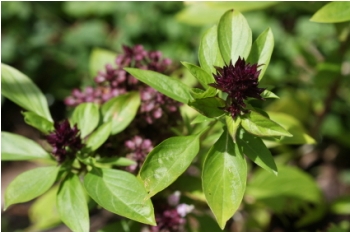Thai Basil
Thai Basil is sweeter than its European counterpart. It is also known as Sweet Basil or Asian Basil. Its Thai name is bai horapa. You will typically find it used with Indian and Thai dishes which call for a little zest.
This basil (Ocimum basilicum cultivar) has small leaves (long and narrow) and purple stem. It has a subtle mint or licorice flavor. A variety typically used in the US is "Queen of Siam". The horapa variety, along with Thai Holy Basil (Ocimum tenuiflorum) and Thai lemon basil are used in Thai cooking. The three are used in different ways due to their different flavors.

Have you grown, tasted, cooked with or had any experience at all with this basil variety? If you have, I'd love to hear about it! Share your experience here.
Growing Thai Basil
 For this basil to prosper, it needs two key things: plenty of sunlight and well drained soil. The notable exception is the Queen of Siam variety that takes at most about 4 – 5 hours of sun per day. The plants will generally grow to 2.5 feet high and wide, so allow for space.
For this basil to prosper, it needs two key things: plenty of sunlight and well drained soil. The notable exception is the Queen of Siam variety that takes at most about 4 – 5 hours of sun per day. The plants will generally grow to 2.5 feet high and wide, so allow for space. The plants can be grown either from seed or as a live plant. Seeds can be started indoors in a shallow container. Seeds should not be planted outdoors until the threat of frost has passed and the nights can be trusted to stay above 50°F.
Spread seeds thinly and cover with 1/8" of rich soil. If you purchased plants, grow in rows 12" – 18" apart. Expect germination in one to two weeks. Keep in heavy sunlight, around 4 – 6 hours per day while keeping the soil moistened. Do not over-water!
Your plants are ready to move outside once they reach 2 – 3". Since the the root system is very vigorous, plant them 8 – 10" apart in well-drained (moist) soil. Allow the soil to dry out before the next watering. Keep the soil rich by using fertilizer and compost.
Make sure you nip off the flowers so that the plant continues to grow leaves versus flowers. When time to harvest, take the leaves from the top of the plant (or cut off the top 1/3 of the plant) and heavily fertilize the plant after each harvest. Ideally, harvest what you need, but it can be kept in the refrigerator for a few days.
Start Your Thai Basil Experience
If you are a coupon or deal shopper, you will now find the latest deals and coupons from our various partners. In addition, there is a search box that will help you locate a specific deal or coupon for what you are looking for. If a code is needed, click on the box, and it will reveal the code and take you to the store. If no code is needed, simply click on the box, and a new window will open for the store.
Tell Us About Your Thai Basil Encounter!
Have you grown Thai Basil? Do you cook with Thai Basil? Do you have a favorite recipe using Thai Basil? Share YOUR Thai Basil encounter here!






New! Comments
Let's hear from you! Leave me a comment in the box below.